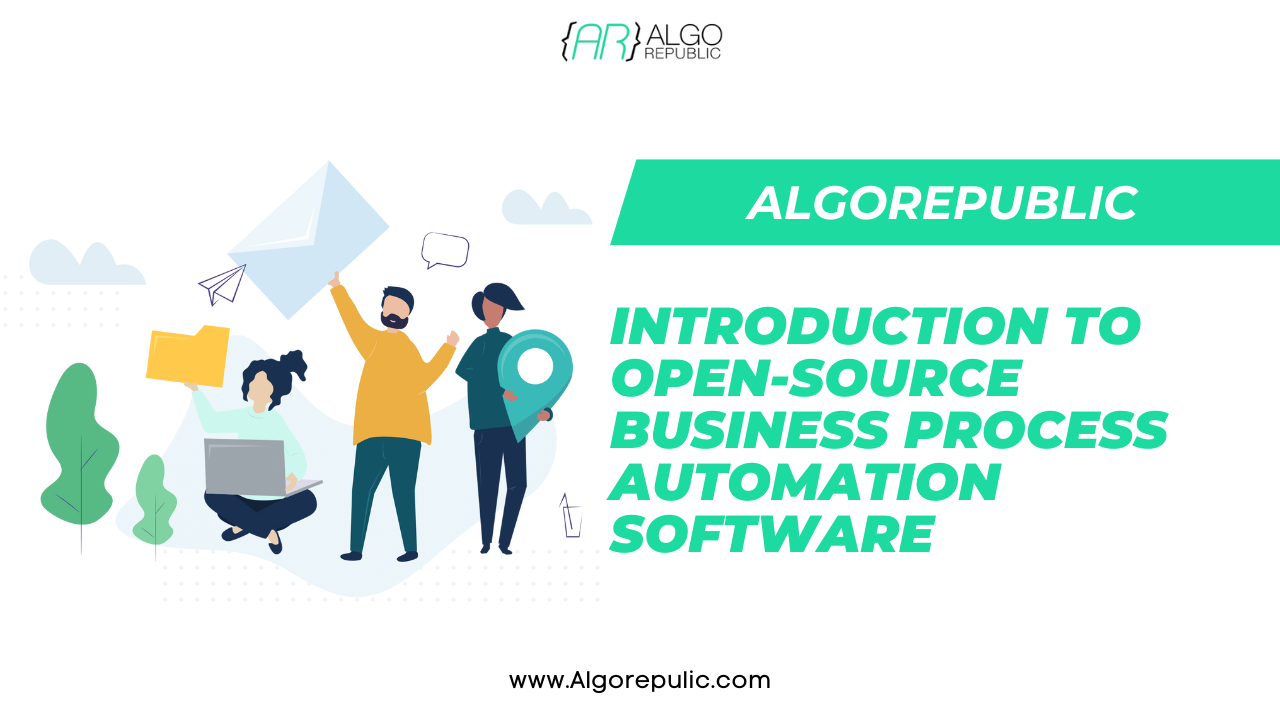Table of Contents
Due to the growing demand for more efficient and adaptable business operations, Open Source Business Process Automation Software has emerged. These innovative tools revolutionize workflow management by promoting transparency, collaboration, adaptability, and innovation within companies. Through utilizing open source BPM solutions, businesses can easily optimize their processes while promptly adapting to changing market demands.
Open Source Definition and Overview:
Open Source Business Process Automation Software has come up in response to the requirement for streamlined and flexible business workflow operations. This innovative category of tools drastically transforms how organizations handle their workflows, promoting collaboration, transparency, creativity as well as adaptability. Utilizing open source BPM solutions empowers businesses to optimize processes effortlessly while promptly reacting to ever-changing market desires.
Evolution and Adoption in the Business Landscape:
The evolution of open source BPM software represents a shift from limited business automation application to widespread adoption in diverse industries. In today’s economy, companies prioritize cost effectiveness, flexibility and crowd-sourced development; thus integrating these solutions is fundamental to improving business operations.
This transition symbolizes moving away from rigid proprietary systems towards custom automation tools customized for each enterprise’s unique demands.
Differentiating Factors from Proprietary Solutions:
The key differentiator of open source BPM is its distinctive features. Unlike proprietary solutions which have big licensing costs, open-source alternatives provide economical means for organizations to implement comprehensive process automation strategies.
The flexibility inherent in the open-code programming allows businesses to adjust solutions precisely tailored towards their needs, leading them away from restricted one-size-fits-all systems typical among proprietary versions. Besides this, collaborative input through an active development community ensures a lively approach driven by shared knowledge and constant updates; something traditional solutions may not always achieve
Benefits of Open Source Solutions:
The Open Source Business Process Automation Software is an innovative solution that outshines proprietary options with its many benefits. This software has now become the preferred choice for companies wanting to simplify their operations and attain maximum productivity.
Cost-Effectiveness and Affordability:
Open source solutions offer a significant advantage in terms of cost-effectiveness. In contrast, proprietary software often requires costly licensing fees upfront and continuous expenses which are eliminated with open source BPM. This permits businesses looking for automation to allocate budgetary resources more strategically towards areas that produce concrete business value like innovation and growth instead of monetary barriers restricting them.
Flexibility and Customization Options:
The flexibility offered by open source BPM software is incomparable and enables organizations to customize solutions according to their unique requirements. The source code access allows businesses to adapt the custom automation software seamlessly with current workflows and systems, a crucial aspect in dynamic business environments where rapid adaptation is essential for success.
Community Support and Collaboration:
For open source solutions to flourish, a dynamic and committed community is crucial. The synergy among users, developers and institutions promotes an environment of information exchange and assistance – the foundation upon which this ecosystem thrives. By embracing this communal approach, software automation challenges can be tackled from diverse perspectives resulting in faster problem solving, continual growth of the technology standard within industries – propelling collective ownership for all involved parties.
Transparency and Security:
Transparency forms the fundamental basis for open source software and it promotes heightened security protocols. Companies are granted access to source code, enabling them to closely examine and verify implemented safety measures.
This openness fosters user trust in understanding the process of automation software, minimizing potential threats that could be overlooked. Additionally, collaborative efforts within open Source development allow for quick action towards addressing any identified security vulnerabilities by a community-driven approach.
Key Features and Functionality:
Open Source Business Automation Software is a standout solution for achieving operational excellence and optimized business processes. Its impressive variety of features and functionalities make it an excellent choice to explore when seeking improved efficiency and adaptability in workflows. Let’s take a closer look at the key components that establish open source BPM as a cornerstone approach to these goals.
Workflow Design and Automation:
The exceptional capabilities of open source BPM revolve around its potential to create, visualize and automate workflows. Organizations can seamlessly design intricate automation workflows using the user-friendly automation interfaces and intuitive design tools available at their disposal.
Drag-and-drop functionality along with visual representations helps both technical and non-technical users define, optimize a variety of complex business processes quickly. This feature is highly efficient in enhancing business workflow structure comprehension which improves collaboration while providing an overview across all teams involved within the organization.
Integration Capabilities with Existing Systems:
The significance of smooth incorporation with current systems is recognized by open source BPM solutions. They boast APIs, connectors and the ability to be adapted to numerous data formats that guarantee an easy software integration with an organization’s wide range of technological infrastructure.
This flexibility helps minimize interruptions as new automated processes efficiently coexist alongside existing frameworks – regardless if they are based on older technologies or advanced ones; overall creating a streamlined and integrated conditional system thanks to open source BPMs.
Reporting and Analytics:
Open source BPM is distinguished by its capacity to extract practical ideas from business procedures. Through powerful reporting and analytics tools, businesses can gain a complete understanding of their workflows.
By measuring key performance indicators (KPIs) and observing process metrics, decision-makers are equipped with valuable information for enhancing efficiency levels. Access to real-time insights into operational performances creates opportunities for continuous progress that enables companies to adapt rapidly in response to changes within the industry landscape.
Scalability and Performance:
Open source BPM solutions are developed to expand effortlessly along with an organization. Whether overseeing a limited project or coordinating complex processes that involve the entire enterprise, this process automation software guarantees great performance.
Scalability is indispensable in accommodating greater workloads and adapting to changing business needs without affecting efficiency. The software’s ability to sustain outstanding execution levels even amidst heavy workloads ensures organizations can confidently count on open source BPM for backing their growing operations.
BPM Implementation: Optimal Strategies and Techniques
- Identify relevant stakeholders from various departments of the organization, including executives, heads of different sectors and operations as well as end-users.
- Encourage open communication and collaboration amongst all stakeholders in order to obtain their approval and agreement on project goals and objectives.
- Ensure active participation of stakeholders in the decision-making procedure and solicit their feedback on matters including, but not limited to process design, automation prerequisites, and performance metrics.
Process Mapping:
- Perform comprehensive process mapping activities to record existing workflows, recognize problematic areas, and discover areas for improvements
- Visualize workflow processes and their dependencies by utilizing visual aids such as flowcharts, swimlane diagrams, and process models.
- To make sure that the process documentation is accurate and complete, involve both subject matter experts and process owners in the mapping phase.
Managing Change:
- Create a detailed plan for managing change that encompasses the human aspects of implementing BPM software open source. The emphasis will be on reducing opposition to changes and encouraging user acceptance.
- Emphasize to stakeholders and end-users the advantages of open source BPM tools, highlighting its ability to enhance efficiency, simplify operations, and assist in achieving strategic goals.
- Offer guidance and assistance to aid staff in coping with alterations in workflows, tools, and procedures. Solve any issues or difficulties that they might face by providing necessary training.
- Assess the appropriateness of BPM software options in light of your company’s distinct demands, specifications, and financial limitations.
- Opt for a platform equipped with durable functionalities in process modeling, automation, analytics and integration with present systems and technologies.
- Maximize efficiency and minimize disruption through seamless integration with other business applications, databases, and systems.
- Before fully implementing BPM solutions, it is recommended to conduct pilot tests or proof-of-concept projects to verify their effectiveness.
- Gather insights from users during trial runs and incorporate them into the enhancement of processes, workflows, and automation protocols.
- Take an iterative approach when implementing and concentrate on gradual enhancements while consistently refining your strategy founded upon feedback and performance benchmarks.
Performance measurement and continuous improvement:
- To evaluate the effectiveness of BPM programs, including cycle time, process efficiency and cost savings, establish key performance indicators (KPIs) and metrics.
- Develop a system that uses the reporting and analytical features of BPM software open source to monitor and scrutinize performance in processes.
- Use performance data to spot chances for streamlining, tackle obstacles, and foster ongoing enhancement in operational workflows.
Organizations can achieve greater efficiency, agility, and competitiveness by effectively planning, executing and optimizing BPM implementation through following these best practices.
Popular Open Source Business Process Automation Software:
Numerous open source BPM solutions have emerged as dominant players thanks to their latest features, versatility and robust support from the community. Here are some of these top-tier choices, examining their essential functionalities, possible applications and level of acceptance among various communities and sectors.
Apache Airflow:
Overview:
Due to its exceptional capabilities in scheduling and orchestration of dynamic workflows, Apache Airflow is highly favored for both flexibility and expandability.
Use Cases:
Commonly utilized in the orchestration of data pipelines, ETL procedures, and fields such as machine learning and data analysis.
Adoption:
The community support and industry adoption prove to be flourishing, especially in the fields of data science, finance and healthcare.
Camunda BPM:
Overview:
Camunda BPM is renowned for its intuitive interface and powerful workflow management, providing support for versatile process design and execution through adherence to the BPMN 2.0 standards.
Use Cases:
Utilized in the management of business processes, case handling, automation of decisions, and coordination of microservices.
Adoption:
Industries including finance, telecommunications and manufacturing have all embraced the robust contributions of their respective communities.
Activiti:
Overview:
Activiti is a BPM platform that delivers both strength and agility while following the guidelines of BPMN 2.0 standards. It provides an intuitive interface as well as complete workflow management capabilities.
Use Cases:
Frequently employed in automating business processes, managing workflows and handling cases.
Adoption:
Its user-friendly Java-based approach has gained popularity across various sectors such as government, healthcare, and IT like software development companies through growing community support and industry usage.
Bonita:
Bonita is a flexible BPM platform for building personalized, efficient, and scalable business applications. This monitoring helps organizations track operational efficiency and identify areas for improvement. Bonita also supports process optimization by providing analytics and insights into process performance, allowing users to refine workflows and enhance overall business agility.
jBPM:
jBPM is a flexible Business Process Management (BPM) Suite that allows you to model, execute, and monitor business processes. jBPM’s execution engine manages processes, handling business rules, and orchestrating workflows across distributed systems. Integration capabilities are robust, supporting connectivity with enterprise systems through REST APIs, Java APIs, and external connectors.
JBPM offers comprehensive monitoring features, including real-time dashboards and customizable reports, to track process instances, monitor task progress, and analyze workflow performance to improve efficiency.
Flowable:
Flowable is a compact and highly efficient workflow and Business Process Management (BPM) engine. Flowable’s workflow engine executes BPMN processes, managing task assignments, process orchestration, and integration with external systems. Integration capabilities include REST APIs and Java APIs, enabling seamless connectivity with enterprise applications and services. Flowable offers monitoring and analytics features to track process instances, monitor workflow performance, and analyze process metrics in real-time.
Zeebe:
Zeebe is a workflow engine for microservices orchestration. It is designed for scalability and can handle large volumes of workflow instances. Monitoring capabilities in Zeebe include real-time dashboards and metrics for tracking workflow instances, task execution times, and system performance.
This monitoring functionality supports organizations in optimizing microservices workflows, improving operational efficiency, and ensuring reliable process execution across distributed systems.
Odoo:
Odoo includes an open-source BPM module that allows you to automate and manage business processes within its ERP framework. Odoo’s BPM module features a graphical editor for designing workflows and process automation rules. It supports the integration of business processes with other Odoo modules, such as CRM, Sales, Inventory, and HR, facilitating end-to-end process automation within the organization.
Furthermore, Odoo’s BPM capabilities include task management, approval workflows, document management, and integration with external applications via REST APIs and webhooks. Monitoring features in Odoo allow users to track workflow statuses, monitor task progress, and analyze process performance through built-in reporting and analytics tools.
Certainly! Here’s a brief overview of each of these tools:
Bitrix24:
Bitrix24 is a comprehensive platform that includes CRM, project management, and collaboration tools alongside business process management capabilities. It offers visual process modeling tools for designing workflows and automating business processes within teams. Bitrix24’s BPM features enable task management, document approval workflows, and integration with other Bitrix24 modules, enhancing team productivity and organizational efficiency.
Bizagi Modeler:
Bizagi Modeler is a free BPMN process modeling tool that allows users to create and optimize business processes. It supports BPMN 2.0 standard and provides a user-friendly interface for designing workflows visually. Bizagi Modeler helps organizations streamline operations by modeling processes, identifying bottlenecks, and improving efficiency through process automation and optimization.
ProcessMaker:
ProcessMaker is an open-source BPM and workflow management software that enables organizations to automate business processes. It provides a graphical interface for designing workflows using BPMN 2.0 and includes features for task management, form design, and integration with external systems through REST APIs. ProcessMaker supports workflow automation across departments, improving collaboration and operational efficiency.
Alfresco:
Alfresco is an open-source ECM (Enterprise Content Management) platform that includes BPM capabilities for managing business processes. It allows organizations to define and automate workflows, manage documents and content, and collaborate securely across teams.
Alfresco integrates with other enterprise systems and provides advanced document management features, enhancing regulatory compliance and operational transparency.
Bonitasoft:
Bonitasoft is an open-source BPM platform for building business applications. It offers tools for process modeling using BPMN 2.0, execution of workflows, task management, and integration with external systems through connectors and APIs. Bonitasoft supports process automation and optimization, providing real-time monitoring and analytics to improve operational efficiency and agility.
ARIS Express:
ARIS Express is a free BPMN 2.0 compliant modeling tool offered by Software AG. It allows users to create process models, organizational charts, and other diagrams to visualize and analyze business processes. ARIS Express supports collaborative modeling and provides basic simulation capabilities to evaluate process performance and identify potential improvements.
Red Hat Process Automation Manager:
Red Hat Process Automation Manager is a comprehensive BPM and decision management suite designed for building business automation solutions. It offers tools for process modeling, execution, monitoring, and decision modeling using BPMN, DMN (Decision Model and Notation), and other standards.
Red Hat Process Automation Manager integrates with Red Hat’s ecosystem, supporting containerized deployments and cloud-native architectures for scalable and resilient business process automation.
Modelio:
Modelio is an open-source modeling environment that supports BPMN for business process modeling and UML (Unified Modeling Language) for software modeling. It provides tools for visual modeling, requirements management, and documentation generation.
Modelio helps organizations design and analyze business processes, ensuring alignment between business requirements and IT implementations through comprehensive modeling and simulation capabilities.
Considerations for Implementation:
To optimize the benefits, organizations must take into account crucial considerations in order to achieve a flawless automation software integration. These are some of the key factors that should be considered:
Assessing Business Needs and Requirements:
To ensure a tailored fit and avoid unnecessary complexity, it’s crucial to conduct a comprehensive evaluation of the organization’s business needs and requirements. Specifically identifying the processes that require automation, comprehending workflow complexities, and determining desired outcomes lays the groundwork for selecting an open source BPM solution that is precisely aligned with objectives.
Technical Expertise and Resources:
To successfully implement open source BPM software, a certain level of technical proficiency is required. Before proceeding with the selection process, companies should evaluate their available resources to determine if they possess the necessary skills for customizing and maintaining their chosen solution.
Investing in further training or hiring experienced professionals may be crucial given that navigating through complex configurations during implementation can ensure optimal usage of BPM software tools.
Compatibility with Existing Infrastructure:
The importance of a smooth software integration with established systems cannot be overlooked while selecting an open-source BPM solution. It is essential to pick software that complements the organization’s existing technology stack and infrastructure, making compatibility checks crucial for preventing disturbances during implementation. Evaluating its potential for seamless incorporation with databases, APIs, and other pertinent technologies becomes vital in ensuring continuity as well as minimizing downtime throughout this phase.
Long-Term Maintenance and Support:
Community-driven development is the backbone of open-source solutions, yet enduring success requires a focus on long-term support and maintenance. When considering adoption, organizations must evaluate factors such as the software’s roadmap, level of community involvement, and access to support resources. It’s critical to grasp how updates are handled along with any upcoming enhancements or patch releases that might be necessary for longevity and security purposes. Developing an ongoing maintenance plan involving routine monitoring/updates will help keep your BPM system agile while addressing business needs over time.
Future Trends and Developments in Open-Source BPM:
The future of Open-Source Business Process Automation Software (BPM) appears bright, with strides expected through the incorporation of cutting-edge technologies such as Artificial Intelligence (AI) and Robotic Process Automation (RPA).
These new advancements will boost BPM capabilities by automating rule-based tasks and improving decision-making. The industry is also predicted to shift towards low-code or no-code platforms that would simplify process design significantly.
Moreover, user experience innovations like intuitive interfaces are expected to streamline BPM adoption even further. Industry-specific solutions, decentralized workflow management via blockchain technology, and collaboration with Internet of Things devices present growth opportunities for open-source BPM software development projects.
By embracing these trends in innovation & efficiency enhancement within their technological infrastructure organizations can benefit from the continued evolution of open-source BMP software tools along with valuable progress offered by leading edge emerging tech developments it enables!
Looking for the best business automation solutions tailored to your business needs? AlgoRepublic is here to help! Let’s get started today.



